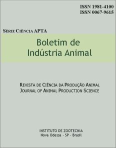Carcass evaluation ot nelore bulls compared with half blood marchigiana-nelore and half blood chianina-nelore
Abstract
The components of the carcass of three type of young bulls: Nelore (NE); Marchigianax Nelore (MA X NE); and Chianina x Nobre (CHI X NE) were compared. Twelve animals of about 18 months old of each type were individually fed in a dry lot, half of them receiving a ration of 60% TDN and the other half a ration of 66% TON. The animals were slaughtered a commercial slaughtering house with average liveweight of 460kg, 478kg and 461kg for NE. MA X NE and CHI X NE respectively. The carcass was separated according to the brazilian commercial system. For comparisons to be made, the carcass components were adjusted for the same cold carcass weight. There was no difference among treatments for cold carcass yield. The total yield of bonelless meat was higher for me NE than for the other two types (P < 0.05). Yields of excess fat trimmed beef were similar for the three types of animals (73.2; 73.1 and 73.1% of the cold carcass respectively for NE; MA X NE, and CHI X NE). The NE type presented a higher value (P < 0.05) for fat thickness (5.2mm) than the MA X NE (2.0mm) and me CHI X NE (2.lmm). The yield of excess fat trimmed beef of the hindquarter was higher (P<0.05) for me crossbreed animals (33.0% for MA X NE and 33.1% for CHI X NE) than for the NE (30.8% of the cold carcass weight). On the other hand, the yield of excess fat trimmed beef of the forequarter was higher (P< 0.05) for the NE (30.8%) than for me crossbreds (28.0% for MA X NE and 29.0% for CHI X NE). No difference was observed among types of animals for Warner Bratzler shear force measured in the Longiimus dorsi muscle. The fat content of the Longiimus dorsi was higher (P < 0.05) for NE (3.36%) than for the crossbreds (1.93% for MA X NE and 1.77% for CHI X NE). The higher energy ration increased significantly (P < 0.05) only the renal and pelvic fat and the flank weights.Downloads
Downloads
Published
Issue
Section
License
Os autores não serão remunerados pela publicação de trabalhos, pois devem abrir mão de seus direitos autorais em favor deste periódico. Por outro lado, os autores ficam autorizados a publicar seus artigos, simultaneamente, em repositórios da instituição de sua origem, desde que citada a fonte da publicação original seja Boletim de Indústria Animal. A revista se reserva o direito de efetuar, nos originais, alterações de ordem normativa, ortográfica e gramatical, com vistas a manter o padrão culto da língua e a credibilidade do veículo. Respeitará, no entanto, o estilo de escrever dos autores. Alterações, correções ou sugestões de ordem conceitual serão encaminhadas aos autores, quando necessário. Nesses casos, os artigos, depois de adequados, deverão ser submetidos a nova apreciação. As opiniões emitidas pelos autores dos artigos são de sua exclusiva responsabilidade. Todo o conteúdo deste periódico, exceto onde está identificado, está licenciado sob a Licença Creative Commons Attribution (CC-BY-NC). A condição BY implica que os licenciados podem copiar, distribuir, exibir e executar a obra e fazer trabalhos derivados com base em que só se dão o autor ou licenciante os créditos na forma especificada por estes. A cláusula NC significa que os licenciados podem copiar, distribuir, exibir e executar a obra e fazer trabalhos derivados com base apenas para fins não comerciais.













